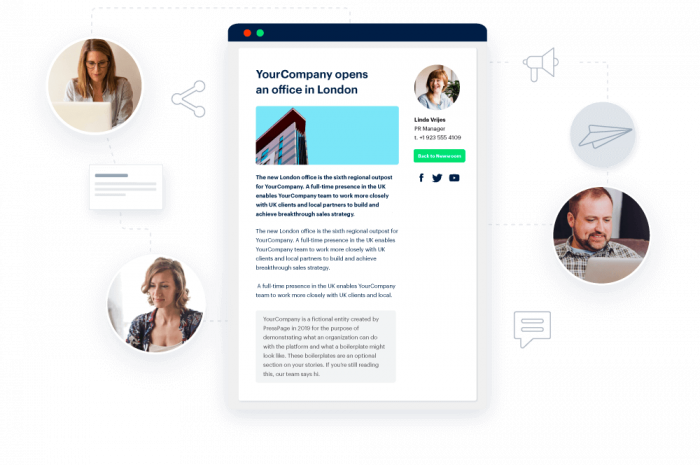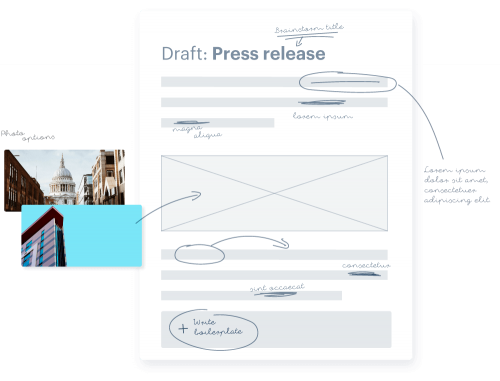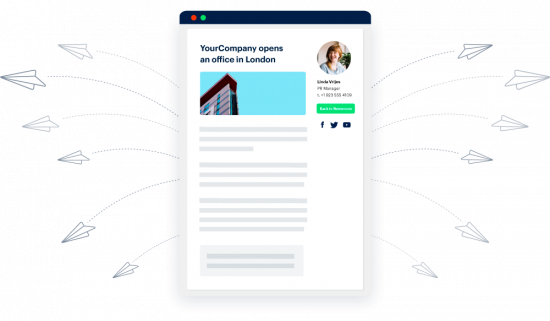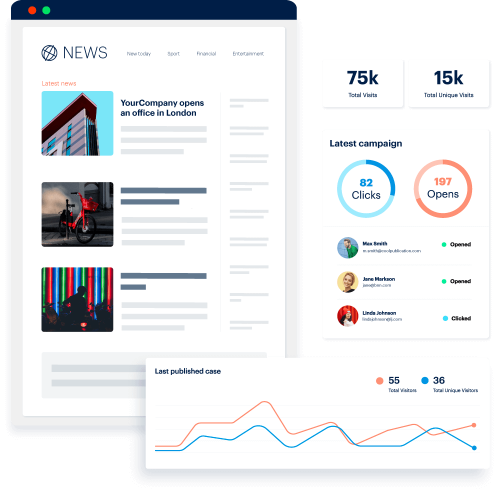The ultimate guide to PR distribution
Get coverage for your stories and reach the right audiences

Why PR Distribution?
This guide aims to support busy newsrooms who want to know the best ways to distribute their news. Press releases are an essential feature of a Public Relations professional’s toolkit. They allow you to get an important announcement or piece of news out to relevant journalists in a timely and efficient way.
Usually, a press release has a headline, a few paragraphs describing the news, and some quotes from senior leaders at your organisation. They can be used to announce:
- Your quarterly or annual financial results
- IPOs, mergers and acquisitions, or stock offerings
- The appointment of a new CEO or changes to your company’s Board
- Important new product launches
- Major milestones like 50 years in business or reaching 100,000 customers
- Recruitment drives
- A community initiative as part of your Corporate Social Responsibility programme
It’s important not to send all of the above types of press releases to the same journalists – your quarterly financial results will be of interest to business journalists, whereas a big charity event you’ve hosted may be of more interest to a lifestyle journalist.
Press releases are used when you want to communicate something to a large group of journalists and editors at once. For smaller news, you might choose to offer an interview to one specific publication.
In this guide, we’ll illustrate how important it is to ensure that your press release distribution system makes sure you get your news to the right journalist. We will cover:

How to secure earned media
A guide to understand the current media landscape and strategically approach earned media

1
What is PR distribution?
At most organisations, preparing a press release takes up a lot of time and resources. It involves the PR team, subject matter experts from different departments, and senior leaders who need to approve it.
Since so much effort goes into getting press releases just right, it’s important to make sure they are seen and published by as many news organisations as possible. That’s what PR distribution is all about.
It’s essential that your news reaches the right journalist at the right publication at the right time. In this guide we’ll discuss building relationships with the media, newswires and how to do outreach that connects.
The major goals of PR distribution
When you develop your annual PR strategy, you’ll set objectives or goals for the coming year. One of the primary goals of Public Relations is to manage your company’s public image. Reputation management, securing share of voice, crisis management, and building affinity are also functions of the Public Relations department.
Secondary goals might include improving brand recognition, increasing awareness of a product or service, and positioning your brand as thought leader.
Many companies do this by crafting key messages when they plan out their PR calendar and trying to reinforce them as often as possible through their PR activity. The public usually needs to hear a key message more than once for it to sink in, so it’s important to choose just two or three and drive them home often.
| Corporate goal | PR key message | Potential actions |
| A health insurance company wants to sell more policies | We have the most comprehensive coverage in the market | Make the CEO available for press interviews on new, totally comprehensive product |
| A start-up wants to generate new investment in their AI product | This start-up is going to revolutionise AI and generate lots of profit | Invest in thought leadership & speaking opportunities to build name recognition |
| A beauty brand that wants to sell more lipstick | The beautiful lip colour lasts more than 12 hours | Send samples with press release to beauty journalists & influencers |
The success of this strategy might be measured by looking at how often one of the company’s key messages is mentioned in an article that mentions them.
Read our blog post and find out more about the importance of developing a PR strategy: Digging in: the importance of developing a PR strategy |
Fail to prepare, prepare to fail
There are a number of components to a successful press release, and preparation is key. As you draft the text, keep the intended audiences in mind. This includes both journalists and their readers. Make sure the messages you’re conveying align closely with your organisational goals and Public Relations goals. What story are you telling, and why?
It’s especially important to have all the supporting media ready and available. For most press releases that means:
- Body copy: The main text of the release, which can include a headline, a sub-headline if required, and a few paragraphs describing the who, what, when, where and why as well as come quotes.
- Images: It’s important to include one or more supporting images: These should be action shots that grab the eye and relate directly to the content. Include low res images to keep the email file size low, but let editors know that the high resolution versions are available for any print outlet that needs them.
- Boilerplate: This comes at the end of the press release and gives any additional information about the company a journalist might need. It’s usually a condensed version of your ‘about us’ page in a single paragraph. Keep this short and sweet, including only the essentials.
- Media kit: A media kit gives journalists a truly comprehensive picture of your organisation. It can include key stats from your annual report including financials, staff numbers, and the company’s vision and mission. Generally, it includes generic company photos the journalist can use for stories, and press contact details. It might also include but it’s important to have it to hand in case it’s needed. If your company hosts it on their website, you could include a link at the end of your boilerplate. Read more about media kits and how to create one.
- Contact details: Who should the journalist ring if they have follow-up questions, or want to arrange an interview with someone at your organisation. Make sure this information is up-to-date and accurate, and that the responsible person always replies to journalists promptly.
In some cases, you may need to tailor your news for different audiences. For example, when Facebook wants to implement new changes to their privacy settings, they need to explain to users why this protects them better, to governing authorities how this complies with the law, and to shareholders why this makes sense from a business point of view.
Is it possible to get all those messages across in one press release? Probably not. The Financial Times will be most interested in how it affects the business, but TechCrunch will be more interested in how the changes will be implemented, while BuzzFeed will want to explain the move to Facebook users. You need to cater for all three. For big news, you may have to issue the same news in a number of different press releases aimed at different audiences.
Journalists and editors are busy people; the goal is to make it as easy as possible for them to understand your news and write about it in a way that your message reaches your audiences.
Before you issue your press release, take a moment to ensure that everything “clicks” – that your story is compelling, you’ve mapped your audiences and you’re tying it all back to your PR strategy and campaign goals.

2
Distributing your content
Once the content is ready to go, it’s time to do your research. Try and answer the following questions:
- What outlets have covered you in the past?
- Who covers your competitors most often?
- Are there any new publications or prominent blogs you can include that you didn’t look at last time?
- Who are the most well known journalists in your sector?
The most important thing to establish is that you’re choosing the right channel to tell your story.
Once you’ve done your research and you know exactly who you want to target, it’s time to start pitching. In this guide, we’ll talk about personal pitching to the most important publications on your list, and how to do mass pitching right when you’re issuing a release more widely.
The golden rules of pitching
1. Hit the deadline
Publications won’t want to cover old news. Make sure you’re aware of their print deadlines (most media outlets make them available online) and try your best to meet them.
2. Target the right people
One of the biggest bugbears journalists have with PR distribution is that they get targeted with press releases that fall way outside their scope. A business journalist who focuses on mergers and acquisitions doesn’t want to know about the new lipstick a beauty brand just launched – but a lifestyle editor at the same publication might be interested. It’s important to be laser focused.
3. Know the publication
It’s impressive to journalists and editors if you can demonstrate in a pitch that you know their publication well. Flick through the latest edition or click through the website and tell them what section you think it would work really well in, and why it suits that particular audience. This can be a time-consuming process but it’s a question of quality versus quantity, and this approach delivers high quality coverage.
4. Talk about them, not you
Editors want stories that are going to be interesting and valuable for their readers. Make sure to spell it out in the subject line. They don’t care about your company or what you’re doing unless you can illustrate why it’s information their audiences would need.
5. Get to the point
Many journalists receive dozens of press releases every single day. Their inboxes are overwhelmed with different companies vying for attention. Once again, you need a killer headline to stand out, and a short, sharp pitch that gets to the point without taking up too much of the journalist’s day.
6. Respond to any follow-ups promptly
Success! A journalist wants to publish your story, and they have some follow up questions for your CEO. This is great news. But if it takes you three days to come back to them, the chances are it’s too late. Newsrooms these days are under pressure, the news cycle is fast, and journalists file stories quickly. If you can’t get the answers from your CEO within a few hours, arrange for a deputy to do it, like your CFO or Head of Innovation, depending on the story.
7. Make sure your content is compelling
Most importantly of all, ask yourself – is this story really newsworthy? If it is, is the press release well written? Does it flow well? Are the images you’ve included of a professional quality that could be used in a newspaper? Are they aesthetically pleasing? Don’t hit send on that press release until you’re sure you’ve made it as engaging as possible.
Building relationships
Naturally, journalists are most likely to open emails from PR professionals they have an established relationship with – and they are far more likely to print your news if this is the case. Start building relationships with journalists that cover your sector as soon as you can.
Most journalists are specialists; they have a ‘beat’ that they cover and in many cases even when they move from one media outlet to another, they continue covering that same beat. That means it’s crucial for you to build personal relationships with the journalists who are most influential in your sector.
This can include making an effort to get to know them in person at networking events, conferences and trade shows; inviting them to a ‘behind-the-scenes’ look at what goes on at your company and engaging with them online – most journalists are very active on Twitter.
It also means doing your job well: if a journalist asks for a comment for an upcoming story, give them something that’s worth reading and not some overly corporate mumbo jumbo. Make sure you provide real insight into their story rather than giving them a sales pitch – it’s not the time or the place. And most importantly, make sure to get the comment over to them ahead of their deadline.
One great way to build relationships with targeted journalists is to offer them exclusives. Sometimes, instead of issuing a press release to get news out as widely as possible, you want to have an in-depth conversation with a journalist who is friendly with your company. In this instance, you offer the journalist a ‘scoop’ in return for coverage.
If you are quick to supply comments and generous with exclusives, the journalists you have built these relationships with are likely to publish the news you issue via press release too.
Say no to newswires
Newswires are generally considered to be an ineffective and expensive way to distribute press releases – and unless you have an enormous budget there’s really no need for them. Newswires distribute your press release incredibly widely, and it’s likely you’ll pick up obscure coverage from publications and blogs you’ve never heard of. It’s exactly the opposite to the type of coverage you want.
The temptation to put a press release on a newswire comes mainly from the fact that it’s incredibly easy; you upload your press release to the site and they wire it to all kinds of publications. However, most newswires are very expensive, and it’s not a good use of your PR budget.
It’s a better idea to invest in your outreach programme – for a fraction of the price you pay a newswire, you could hire a freelancer to help you follow up with journalists over the phone, doubling the number of publications that hear from your organization personally. Or you could spend that money providing high quality samples of your new products so journalists can try them out for themselves.
So, if newswires are a part of your PR strategy right now, it might be time to have a rethink. In many cases, you’ll find your press release has been picked up by a handful of websites that are completely unrelated to your industry and simply syndicate press releases for SEO purposes.
Trade publications
Most industries have magazines or online zines dedicated specifically to them. From insurance to oil and gas to everything else, there will be a place where your industry’s news is curated. Trade publications are often an easy win in securing coverage for your press release.
This is because they are specifically focused on your niche, and they are often more willing to cover things like new product launches that national newspapers would prefer you bought advertising space to promote. The readers of these publications are very often your target audiences, so it’s crucial to build relationships with trade publications as well as national and regional titles – especially if you work in the Business to Business space.
Managing media databases
So, while you may be able to build strong personal relationships with a handful of key journalists, how can you make sure you get it right when you’re sending a major global news release to hundreds of journalists in dozens of countries? How do you keep your pitches relevant?
An out of date Microsoft Excel file hidden somewhere on your server and updated infrequently probably isn’t going to work. If you work in many countries and across a variety of different sectors, it may not be possible to have a personal relationship with all the journalists you need to keep in touch with. For this reason, media databases have become more popular in recent years.
So what’s the right way to do a mass pitch?
Maintaining a media database for your organisation manually is tough – it’s hard for one internal individual or team to keep up with what journalists are new to the beat, have moved to another publication or have left the field.
It’s crucial to be able to build lists of active, engaged journalists easily. For that reason, most PR software offers this function, with contact details for the journalists you need to contact updated in real-time. At Presspage, this database contains more than 1,000,000 contacts that are continually kept up to date. As well as this, Presspage ensures the contact details stored are GDPR compliant, so you don’t have to worry about data law.
A word of warning, however: Many PR professionals use media databases unwisely, firing their press releases out to thousands of journalists around the world with little to no research on who they are and whether it’s relevant to them. This is really irritating for journalists, and is not recommended as a strategy.
Building your media list
Take your time building a media list. All the tips we included above for personal pitching are still very relevant; you need to pitch the right journalist at the right publication. Avoid the scattergun approach of sending your release to eight journalists at one newspaper or magazine, they all sit together and that will just annoy them – find the right person and send it to them only.
The same goes for publications, don’t send your press release about gardening to a magazine that covers the auto industry – it’s just a waste of everybody’s time. Putting a little extra effort into creating a highly curated, personalised list will result in better coverage and better relationships.
With Presspage, you can also monitor who opens your press release or clicks on the links within it, and you can add notes about individual journalists. This gives you a better picture of who you should follow up with directly.
More ways to share your press release
Naturally, you should also publish your press release in your online newsroom. That way, it’s easy to find and reference for any journalist who wants to refer back to it in the future. You can also improve your site’s SEO this way.
Share your press release internally too; make sure your staff get a copy emailed to them so they are always up-to-date on what is happening at the company. If you have an intranet portal, you can post it there too.
Finally, you can also cross-share that to all of your social media channels for distribution to wider audiences.

The ultimate guide to managing a brand newsroom
Everything you need to build and manage a successful brand newsroom.

3
Measuring the success of your PR distribution
Once all the coverage has been compiled for your press release, it’s time to evaluate how well it met its goals. This will happen in a number of ways to measure quantitative and qualitative success. You should create a comprehensive report answering some or all of the following questions.
- How many journalists opened your email, and how many asked follow-up questions?
- How many publications printed or published your news?
- Were your key messages included in the story?
- Was the story featured prominently or buried deep where you had to look for it?
- Were competitors also mentioned?
- How many visitors did the press release on your website get?
You should also compile a coverage book, with clippings of all the coverage you earned.
Once you have compiled your report and coverage book, you can share this with senior management to demonstrate the value of PR to the organization. This can influence your budget for the following year; by demonstrating your success clearly you justify the PR spend.
The last step is to look for learnings. Are there ways to improve the process, work more efficiently or get better outcomes next time?
Conclusion
When you put a huge amount of effort into creating a press release, it makes sense to do the best job you possibly can on distributing it too. Create coverage reports you can be proud of and build long-term relationships with the key movers and shakers in your industry.
Public Relations is still one of the most effective ways to manage your company’s reputation, build the profile of your senior leaders, and establish your organisation as one that can offer true insight on your industry. It’s a crucial function in managing a crisis or scandal at your organisation. A solid PR team can make a direct contribution to your share prices and bottom, so don’t hold back on investing in it.
